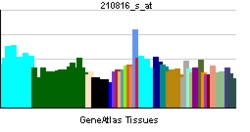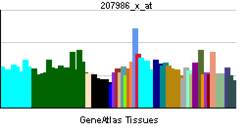- CYB561
-
Cytochrome b-561 Identifiers Symbols CYB561; FRRS2 External IDs OMIM: 600019 MGI: 103253 HomoloGene: 37552 GeneCards: CYB561 Gene Gene Ontology Molecular function • ferric-chelate reductase activity
• cytochrome-b5 reductase activity
• metal ion bindingCellular component • integral to plasma membrane
• membraneBiological process • generation of precursor metabolites and energy
• transport
• electron transport chainSources: Amigo / QuickGO RNA expression pattern 


More reference expression data Orthologs Species Human Mouse Entrez 1534 13056 Ensembl ENSG00000008283 ENSMUSG00000019590 UniProt P49447 Q8CE89 RefSeq (mRNA) NM_001017916.1 NM_007805.4 RefSeq (protein) NP_001017916.1 NP_031831.2 Location (UCSC) Chr 17:
61.51 – 61.52 MbChr 11:
105.8 – 105.81 MbPubMed search [1] [2] Cytochrome b561 is a protein that in humans is encoded by the CYB561 gene.[1][2]
References
- ^ McBride OW, Yi HF, Srivastava M (Nov 1994). "The human cytochrome b561 gene (CYB561) is located at 17q11-qter". Genomics 21 (3): 662–3. doi:10.1006/geno.1994.1332. PMID 7959749.
- ^ "Entrez Gene: CYB561 cytochrome b-561". http://www.ncbi.nlm.nih.gov/sites/entrez?Db=gene&Cmd=ShowDetailView&TermToSearch=1534.
Further reading
- Duong LT, Fleming PJ (1982). "Isolation and properties of cytochrome b561 from bovine adrenal chromaffin granules.". J. Biol. Chem. 257 (15): 8561–4. PMID 7096323.
- Srivastava M (1995). "Genomic structure and expression of the human gene encoding cytochrome b561, an integral protein of the chromaffin granule membrane.". J. Biol. Chem. 270 (39): 22714–20. doi:10.1074/jbc.270.39.22714. PMID 7559396.
- Srivastava M, Gibson KR, Pollard HB, Fleming PJ (1994). "Human cytochrome b561: a revised hypothesis for conformation in membranes which reconciles sequence and functional information". Biochem. J. 303 ( Pt 3) (Pt 3): 915–21. PMC 1137633. PMID 7980462. http://www.pubmedcentral.nih.gov/articlerender.fcgi?tool=pmcentrez&artid=1137633.
- Strausberg RL, Feingold EA, Grouse LH, et al. (2003). "Generation and initial analysis of more than 15,000 full-length human and mouse cDNA sequences". Proc. Natl. Acad. Sci. U.S.A. 99 (26): 16899–903. doi:10.1073/pnas.242603899. PMC 139241. PMID 12477932. http://www.pubmedcentral.nih.gov/articlerender.fcgi?tool=pmcentrez&artid=139241.
- Bashtovyy D, Bérczi A, Asard H, Páli T (2004). "Structure prediction for the di-heme cytochrome b561 protein family". Protoplasma 221 (1–2): 31–40. doi:10.1007/s00709-002-0065-0. PMID 12768339.
- Kang MK, Kameta A, Shin KH, et al. (2003). "Senescence-associated genes in normal human oral keratinocytes". Exp. Cell Res. 287 (2): 272–81. doi:10.1016/S0014-4827(03)00061-2. PMID 12837283.
- Vargas JD, Herpers B, McKie AT, et al. (2003). "Stromal cell-derived receptor 2 and cytochrome b561 are functional ferric reductases". Biochim. Biophys. Acta 1651 (1–2): 116–23. PMID 14499595.
- Ota T, Suzuki Y, Nishikawa T, et al. (2004). "Complete sequencing and characterization of 21,243 full-length human cDNAs". Nat. Genet. 36 (1): 40–5. doi:10.1038/ng1285. PMID 14702039.
- Gerhard DS, Wagner L, Feingold EA, et al. (2004). "The Status, Quality, and Expansion of the NIH Full-Length cDNA Project: The Mammalian Gene Collection (MGC)". Genome Res. 14 (10B): 2121–7. doi:10.1101/gr.2596504. PMC 528928. PMID 15489334. http://www.pubmedcentral.nih.gov/articlerender.fcgi?tool=pmcentrez&artid=528928.
Categories:- Human proteins
- Chromosome 17 gene stubs
Wikimedia Foundation. 2010.
